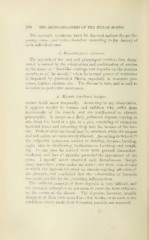Page 362 - My FlipBook
P. 362
334 THE MICRO-ORGANISMS OF THE HUMAN MOUTH.
The systemic treatment must be directed against the predis-
posing cause, and varies therefore according to the history of
each individual case.
d. Stomatoiiijicosis sarcinica.
The mycosis of the oral and pharyngeal cavities, thus desig-
nated, is caused by the colonization and proliferation of sarcina
in the shape of " frost-like coatings and deposits on the mucous
membrane of the mouth," when its normal power of resistance
is impaired l)y protracted illness, especially in marantic pro-
cesses, typhus, phthisis, etc. The disease is rare, and is said to
occasion no particular annoyance.
e. JL/cosis tonsillaris hcnigna
occurs much more frecj[uently. According to my observation,
it appears mostly in women and children who suffer from
hypertrophy of the tonsils, and are predisposed to chronic
pharyngitis. It occurs as a dirty, yellowish deposit, varying in
size from the head of a pin to a pea, consisting of numerous
bacterial forms and extending deep into the lacunae of the ton-
sils. Both or only one tonsil may 1)0 attacked, while the tongue
and soft palate are more rarely affected. According to Schech,-^-
tlie subjective symptoms consist in tickling, dryness, burning,
slight pains in swallowing, inclination to hawking and cough-
ing. In one case he noticed fever with general discomfort;
weakness and loss of appetite preceded the appearance of the
spots. I myself never observed such disturbances, though
many cases have come under my notice, but have seen several
in which the mycosis followed an already-existing affection of
the pharynx, and concluded that the colonization of bacteria
was made possible by the preceding inflammation.
The artificial removal of these deposits is very difficult, and
the strongest antiseptics do not seem to exert the least influence
on the course of the disease. The deposits, however, usually
disappear of their own accord in a few weeks, or as soon as the
conditions which made their furmation possible are removed.


